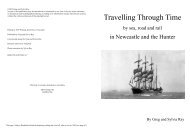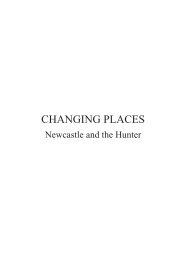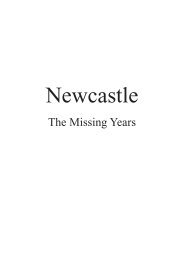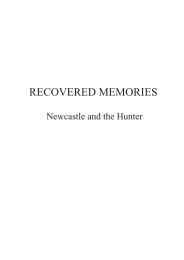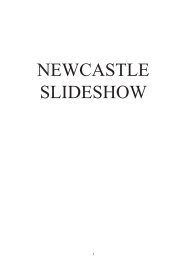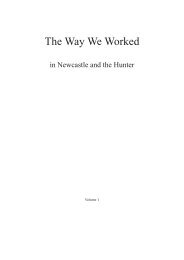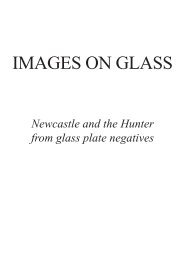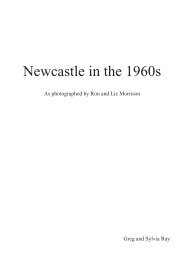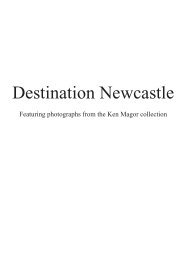Postcards from the Past
Newcastle and the Hunter Region
Newcastle and the Hunter Region
Create successful ePaper yourself
Turn your PDF publications into a flip-book with our unique Google optimized e-Paper software.
Postcards from the Past
Newcastle and the Hunter Region
Greg and Sylvia Ray
Wishing you were here
Keeping in touch was different in the old days.
Instant person-to-person messaging across the globe was too far-fetched to even dream about and early
telegraph and telephone services were beyond the reach of most ordinary people. By the early 1900s,
however (in the western industrialised countries, at least), the postal service was a remarkable system.
The wildly successful concept of the prepaid postage stamp, coupled with greater levels of literacy than
ever before, meant that postal services handled immense volumes of mail. In 2021 the privatisation of
Australia’s postal services is being discussed, and mail deliveries are now only every second day in
many areas. But in the early 1900s the mail was often delivered three times a day, and a card posted in
the morning to a destination in the same city or town would almost certainly arrive the same afternoon.
Postcards appeared at some point in the 1860s when somebody thought up the idea of offering a
simple card for posting brief messages, with a very cheap postal rate. The first official postcards were
government-issued and had no pictures; just an imprinted stamp and spaces for the address and a short
message. Even when pictures began to appear on the cards, these were on the same side as the message,
with one whole face devoted to the address. Soon private interests were allowed to produce postcards, on
condition that these met the standards laid down by postal authorities, and the next major development
was the granting of permission for the address and message to be placed on the same side of the card,
with the entire other face devoted to a picture. The golden age of the picture postcard was in the early
1900s, when the cards were used as a quick and cheap means of sending messages. They were extremely
popular and were keenly sought after by collectors who loved to display them in special albums. It
seems the postcard fad peaked about 1910, but the cards remain very familiar artifacts even today, along
with fold-out photo booklets and sets of smaller souvenir photos, usually issued by the same businesses
that published standard postcards. A small number of the images in this book have been scanned from
such products.
This book is not intended to be a comprehensive survey of postcards with Hunter Region themes, but
rather a broad but shallow view of the region seen through the limited array of cards that have come
my way in recent years. In most cases it’s the image on the cards that is of interest, but sometimes the
messages on the backs are also worth recording for the glimpses and insights they offer into the lives and
times of those who sent and received them. I’ve tried my best to transcribe accurately, and hope I’ll be
forgiven for my mistakes. Now and then I’ve given up and inserted a question mark.
From the point of view of image quality it is obvious that postcards are extremely variable. Some “real
photo” cards are exceptionally fine, while others barely equal newsprint standard. Still, if I found the
subject matter of a poorly printed card interesting enough I’ve assumed at least some readers will too, so
have asked my wife and co-publisher Sylvia to do the best she can with her considerable graphics skills.
This is our 13th volume since we embarked on our publishing venture in 2010, and we would like
to thank the many, many people who have helped us in a variety of ways over the years. In the case of
this volume we especially thank Daphne Barney, Geoff Boyle, Margaret Faulkner, Judy Jackson, Jack
Lawson, Barry Magor, Ardel Prout, Pete Smith and Chris Young. We have no connection or arrangement
with any postcard companies or publishers.
Greg Ray
4
“Here’s a hand ma trusty friend”: words from Auld Lang Syne, the traditional Scottish New
Year song. With so many Hunter residents in the early 1900s having strong family links to
the British Isles, such themes were smart marketing for postcard publishers. The card above
shows the view looking west along Hunter Street, with the Post Office - and some hansom
cabs - on the right. Card below shows a very popular view, from the pedestrian bridge over
the rail line looking east along Scott Street towards Customs House.
5
Postcards were published by a large number of different businesses, some locally based and some from
other parts of Australia. A surprising number were printed overseas, especially in Germany, where highquality
printing technology outstripped what was available elsewhere. The cards on these two pages
were produced by Newcastle printing firm Davies and Cannington. The “Old Newcastle Series” went
through a number of printings, with dates and numerical sequences varying.
6
These two views of The Hill, circa 1870, show the goat-track nature of the streets in the city at the
time, and also show the two leading light towers that were built to help ships enter the harbour.
Skippers and pilots would position their vessels in the channel so that the two lights lined up. The
tower in the photo below remains in place today in Tyrrell Street but the one seen in front of St Mary’s
church in Perkins Street (above) was demolished in the 1930s after falling into disuse and disrepair.
7
This lovely set of cards has no marks of any kind to identify a publisher. The card above is a view of the
harbour and Nobbys from the Cathedral, with some gravestones in the cemetery visible in the foreground.
The construction site at left is the Post Office. The card below shows the harbour futher west, with David
Cohen’s ill-fated warehouse the large building middle right, and a lovely four-masted sailing ship moored
over towards Stockton. Cohen’s warehouse burned down in 1908, which helps date this image.
8
Card number 3 in the series (above) shows the scene still further west, with ships at The Dyke to load
coal. The card below goes further west again, with the coal-loading staithes of the Australian Agricultural
Company seen on the harbour’s edge, and a ship at Callen’s slip, across the water at the right-hand edge
of the shot. King Street Terraces can be seen in the view. These still stand today.
9
The view above shows Tyrrell Street, with the distinctive stepped stone wall that remains in place today.
The card below shows part of Cooks Hill, with Laman Street at right leading towards St Andrews Church.
10




